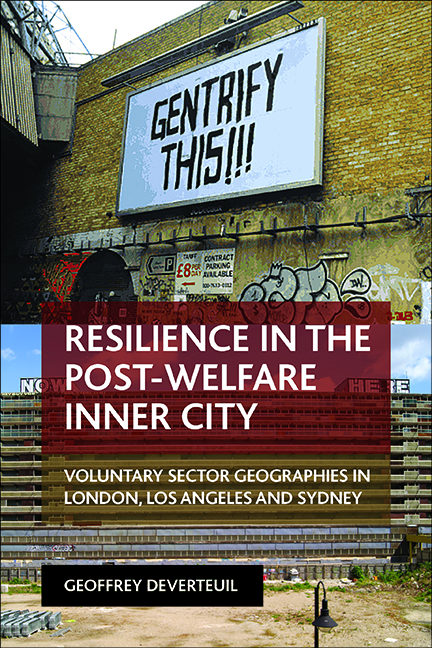 Resilience in the Post-Welfare Inner City
Resilience in the Post-Welfare Inner City Book contents
- Frontmatter
- Dedication
- Contents
- List of tables and figures
- About the author
- Acknowledgements
- Preface
- Part One Introducing resilience in the post-welfare inner city: conceptual and methodological considerations
- Part Two Case studies: spatial and social resilience in London, Los Angeles and Sydney
- Part Three Conclusions, critical resilience, commons and austerity
- References
- Index
Part Two - Case studies: spatial and social resilience in London, Los Angeles and Sydney
Published online by Cambridge University Press: 10 March 2022
- Frontmatter
- Dedication
- Contents
- List of tables and figures
- About the author
- Acknowledgements
- Preface
- Part One Introducing resilience in the post-welfare inner city: conceptual and methodological considerations
- Part Two Case studies: spatial and social resilience in London, Los Angeles and Sydney
- Part Three Conclusions, critical resilience, commons and austerity
- References
- Index
Summary
Part Two presents the empirical material of the comparative study, as well as its analysis. Chapter Five begins the comparative analysis by proposing four place-types across the 10 case studies. Each of the ensuring chapters (Chapters Six to Nine) then focuses on one of the four place-types, in terms of profiling both spatial and social resilience. The results suggested a wide range of resilience strategies adapting to the differing level of threat across the case studies. Chapter Ten compares the four place-types, alongside the three global city-regions themselves.
But before broaching the material on resilience in Chapters Five to Ten, I will briefly consider the pattern and profile of displacement across the sample – that is, to consider the on-the-ground nature of the threat itself before the response.
Close to 20% of all facilities experienced at least one episode of displacement during the study period. This proportion may well be underestimated, given the difficulty in identifying services whose gentrification-induced displacement led to disbandment, as well as limitations of the service databases themselves, which do not pick up smaller, potentially more vulnerable organisations nor exits from the study areas. Yet the proportions may also be overestimated, given that responses may have been biased towards displaced organisations wanting to tell their story. Nevertheless, the proportions, if annualised, were not entirely dissimilar from residential displacement estimates by Marcuse (1985) and Atkinson (2000) in London and New York City, and Atkinson et al (2011) in Sydney and Melbourne. And even if the proportions seemed low, gentrification-induced displacement was greatly significant to the 19 facilities. These included disruption and loss of clientele base, smaller premises, higher and more precarious rental agreements, and lengthy efforts to find new premises within gentrifying neighbourhoods. The rate of displacement pressure was 62%, or three times more likely than the actual displacement rate.
Crucially, the profile of displaced facilities differed from those who were resilient (DeVerteuil, 2011a). Most displaced services were renting from the private market at the time of displacement, and found themselves involuntarily moving because of eviction and/or rent increases brought on by neighbourhood gentrification. Second, a majority were smaller than the average-sized facility in terms of client intake. Third, they relied more on (erratic) donations and client fees than on government funding.
- Type
- Chapter
- Information
- Resilience in the Post-Welfare Inner CityVoluntary Sector Geographies in London, Los Angeles and Sydney, pp. 83 - 86Publisher: Bristol University PressPrint publication year: 2015


